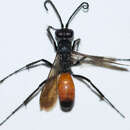Comprehensive Description
provided by Memoirs of the American Entomological Society
Anoplius (Arachnophroctonus) semirufus (Cresson)
Pompilus semirufus Cresson, 1867, Trans. Amer. Ent. Soc, 1: 100 [Type: 9,
Georgia (ANSP, no. 423)]. Pompilus divisus Cresson, 1867, ibid., p. 100 [Type: 9, Georgia (ANSP, no.
424)]. Synonym by Evans, 1951. Arachnophila divisa Ashmead, 1902, Canad. Ent., 34: 86. Arachnodaicter divisus Pate, 1946, Trans. Amer. Ent. Soc., 72: 74. Anoplius (Arachnophroctonus) semirufus Evans, 1951, Trans. Amer. Ent. Soc,
76: 264-267. — Evans, 1964, Jour. Kansas Ent. Soc., 37: 306
(biology). Arachnophroctonus apiculatus pretiosus Dreisbach, 1954, Amer. Midi. Nat.,
52: 440, 442 (S, misidentification).
Female. — Length 7-13 mm. Head and thorax black; abdomen encircled with light orange-brown on at least the basal two segments, more often the basal three, sometimes the entire abdomen of this color except the tip infuscated; wings highly infuscated, darker along the outer margins. Pubescence pale, more or less silvery over most of the body. Body with relatively little erect hair in many specimens, none at all on the femora, propodeum, or abdominal dorsum except for the apical tergite; in other specimens there is an abundance of long, black hair on the femora, sometimes even the tibiae and tarsi, also on the entire abdomen and often the propodeum. Clypeus about 3 X as wide as high, truncate below. Front broad, MID .60-.67 X TFD; UID .70-.82 X LID; third antennal segment equal to from .70 to .85 X UID; POL and OOL usually nearly equal. Posterior margin of pronotum subangulate or subarcuate. Propodeum with the median line distinctly impressed. Mesosternum produced backward on each side of the median line in the form of a pair of spiniform processes. Front basitarsus with three comb-spines, the spines from 1.5 to 3 X as long as the width of the tarsus at their bases. SMC3 triangular or nearly so, sometimes short-petiolate, the third intercubital vein
strongly arched.
Male. — Length 5-9 mm. Black, posterior margin of pronotum sometimes with a pale stripe, basal abdominal segments encircled with light orange-brown; wings hyaline or nearly so, outer margins with a darker band. Body extensively covered with silvery pubescence, which tends to form narrow bands at the apices of the abdominal tergites, especially conspicuous on tergites 4-6, which are otherwise mostly dark-pubescent. Propodeum not at all hairy; venter with only some short, inconspicuous setae toward the apex. Clypeus 2.5 X as wide as high. MID .60-.66 X TFD; UID subequal to or slightly less than LID; OOL usually slightly exceeding POL. Antennae slender, segment three 2.4-3.0 X as long as thick, about as long as four. Posterior margin of pronotum broadly angulate. Median line of propodeum impressed. Last segment of front tarsus rather strongly produced on the inner margin. SMC3 subtriangular, triangular, or petiolate. SGP with the disc weakly, roundly elevated medially, bearing short, suberect setae, the apex tapering to a subacute or very narrowly rounded tip. Genitalia very similar to those of the preceding species, but the parameres relatively somewhat long and more strongly setose (see fig. 120 in Evans, 1951).
Distribution. — In the United States this species ranges from Florida and Texas to Montana, Ontario, and New Brunswick (for marginal records, see Evans, 1951). It has not previously been recorded from Mexico and Central America, and in fact is now known only from Morelos and from one specimen from Guatemala. (Map 47.)
Mexican and Central American specimens examined: 13 2 2,16 8 8. Morelos: 11 25,9 8 8, S end Cuernavaca, Mch.-May 1959, 4500 feet (HEE) [MCZ, CU]; 1 8, Cuautla, 5 July 1961 (FPM) [ENAC]; 1 2,2 8 8, Puente de Ixtla, 2000 feet, 31 July 1962 (HEE) [MCZ]; 4 8 8, Tetecala, 3000 feet, Mch., Aug. (HEE) [MCZ, CU]. Guatemala: 1 2 , Guatemala City (GCC) [BMNH].
Variation. — All the Mexican and Guatemalan females have a certain amount of dark erect hair on the femora and abdominal dorsum, but none on the propodeum. All of them have the abdomen entirely bright orange-brown except for the apical segment, which is variably infuscated. All the males have a strong pale stripe on the posterior margin of the pronotum. In the U. S. specimens I have seen, the apical 2 or to 4 segments of the female abdomen are entirely black and the male has at most an indistinct pale band on the pronotum. Thus the Morelos and Guatemalan population would seem as worthy of subspecific rank as the subspecies of apiculatus now recognized. However, it is possible that when semirufus has been more widely collected in Mexico these color differences will be found to vary clinally. Furthermore, the fact that some species have conventionally been split into weak subspecies does not justify this practice for all species.
- bibliographic citation
- Evans, H.E. 1966. A Revision of the Mexican and Central American Spider Wasps of the Subfamily Pompilinae (Hymenoptera: Pompilidae). Memoirs of the American Entomological Society vol. 20. Philadelphia, USA

